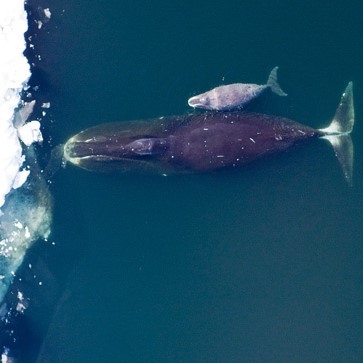
Alaskan bowhead whales
 Based on a long tradition, bowhead whales (Balaena mysticetus) off the North Slope of Alaska are subjects of a well-regulated modern hunt by Alaska Natives. During the spring hunt of 1993, 2 stone harpoon points were recovered from the dorsal musculature of 1 of these whales. Supported by archaeological comparisons, these implements were judged to have been imbedded during unsuccessful strikes by hunters some 100–130 years earlier, substantiating maximum longevity estimates for bowhead whales obtained by a variety of other techniques (George et al. 1999).
Based on a long tradition, bowhead whales (Balaena mysticetus) off the North Slope of Alaska are subjects of a well-regulated modern hunt by Alaska Natives. During the spring hunt of 1993, 2 stone harpoon points were recovered from the dorsal musculature of 1 of these whales. Supported by archaeological comparisons, these implements were judged to have been imbedded during unsuccessful strikes by hunters some 100–130 years earlier, substantiating maximum longevity estimates for bowhead whales obtained by a variety of other techniques (George et al. 1999).
Inuit whalers recognize a whale which looks somewhat different from most bowheads in the population. They call this animal ingutuk. Some Inuit contended that the ingutuk was a different species than the bowhead; some that it was B. glacialis; and others thought it was neither B. mysticetus nor B. glacialis.
It is indisputable that some bowhead whales differ in appearance, morphologically, although it often takes an experienced observer to make the distinction. The most apparent morphological variant is called ingutuk. However, the preponderant circumstantial and direct evidence suggests that a clear distinction between ingutuk and non-ingutuk bowheads cannot always be made. The possibility that the ingutuk is a developmental stage which will grow to become a non-igutuvuk, and presumably a “normal” bowhead, is suggested by the use of the word in some Inuit villages as well as by size comparisons among harvested animals. The discrepancies noted in assigning “ingutuk” to the female gender may, in fact, be because ingutuk is a female sex-related trait, or perhaps simply because of inaccuracies in sexing animals. Although morphometric and genetic-biochemical analyses of bowhead whales are not complete, we believe that the ingutuk is not a species separate from the bowhead. This conclusion is supported by the most experienced Inuit whaling captains we interviewed. While future research will be aimed at further investigation of the explanations presented in this paper, it appears that the ingutuk is within the range of variation in the western Arctic population of bowhead whales.
